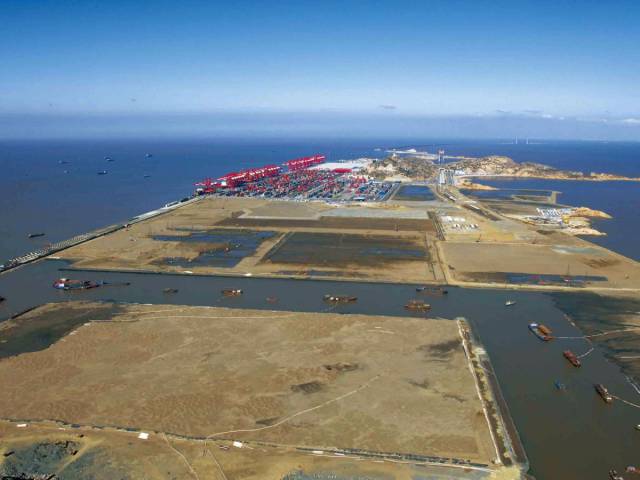China plans to relocate 250 million people to country’s megacities. To do this, they need solid infrastructure. So, they invested billions in huge infrastructure projects. Some of them have been already completed, others are underway. Here are some of the giant and expensive Chinese building projects.
$110 MILLION: The Pingtang telescope was finally turned on in September of 2016, and is now the world's second-largest radio telescope. Its dish measures 1,640 feet across.
$176 MILLION: The Shanghai Synchrotron Radiation Laboratory is where many of China's major scientific projects are conducted. It's the country's most expensive research facility.
$200 MILLION: The Guangzhou Opera House is one of the three biggest theaters in China, designed by architect Zaha Hadid.
$473 MILLION: The Qinling Tunnel is the longest highway tunnel in China, measuring more than 11 miles underneath Zhongnan Mountain.
$532 MILLION: The Hainan power grid project will get a second underwater cable that runs between the southern island of Hainan to mainland China. It's slated to be completed in 2017.
$717 MILLION: The Kashgar-Hotan Railway connects all the cities and towns of the southwestern Tarim Basin.
$760 MILLION: The building that's home to China Central TV Headquarters is a loop of six horizontal and vertical sections, covering 1,551,837 feet.
$900 MILLION: The Tianhuangping hydroelectric project is the biggest in Asia and plays a vital role in supplying power to eastern China.
$1.1 BILLION: The 1,614-foot-tall Shanghai World Financial Center Project (on the right in this picture) is home to the second highest hotel in the world. The Park Hyatt Shanghai is on the 79th through 93rd floors.
$1.3 BILLION: The Baltic Pearl Project is China's largest foreign development project, consisting of residential and commercial properties outside St. Petersburg, Russia.
$1.7 BILLION: The Wuhan Tianxingzhou Yangtze River Bridge is a combined road and rail bridge that crosses the Yangtze River in the city of Wuhan.
$1.7 BILLION: The Nanjing Metro was completed in 2005 and is used by roughly 2 million people a day — that's 717 million people a year.
$1.8 BILLION: The Shanghai Yangtze River Tunnel and Bridge is the fifth longest cable-stayed bridge in the world, at a length of nearly 16 miles.
$1.9 BILLION: The Chengdu Shuangliu Airport is the 4th-busiest airport in Mainland China. In 2015, it handled 42 million passengers.
$2.12 BILLION: The Wuhan Railway Station serves some of the world's fastest trains, which sail along at 186 mph.
$2.2 BILLION: The Qinshan Nuclear Power Plant, Phase 2 was added to the original Qinshan plant in 2011. It has the most nuclear reactors of any site in the world.
$2.4 BILLION: At 128 stories and 2,078 feet tall, the Shanghai Tower is the tallest skyscraper in China. It's the second tallest in the world.
$3.5 BILLION: The Beijing Capital International Airport is the largest single construction project in China and the sixth largest building in the world.
$3.6 BILLION: Opened in 2012, the Kunming Changshui International Airport is the second-largest airport in China. Its main terminal measures nearly 6 million square feet.
$4.5 BILLION: Nanhui New City, a planned city to be completed in 2020, will house almost 1 million people.
$6.3 BILLION: The Xiangjiaba Dam reached completion in 2014. Its generators produce a combined 30.7 Twh of energy annually.
$6.3 BILLION: The Beijing South Railway Station is the city's largest station and one of the largest in all of Asia.
$6.5 BILLION: China is one of several countries that have signed a contract to re-construct the ancient “Silk Road” that links China and India to Europe.
$6.76 BILLION: Xiluodu Dam is the fourth tallest dam in the world and currently the second-largest power source for all of China.
$7.89 BILLION: The Su-Tong Yangtze River Bridge is the world's second longest cable-stayed bridge, covering 3,600 feet between the cities of Nantong and Changshu.
$10.6 BILLION: The Hong Kong-Zhuhai-Macau Bridge project will connect the two huge regions when it's completed in 2017.
$12 BILLION: The Hainan Wenchang Space Center launch project was completed in 2014. It's uniquely positioned to launch a spacecraft that will stay in orbit.
$12 BILLION: The Shanghai Yangshan Deep Water Port Project is an ongoing construction project that aims to handle the largest container ships in the world by 2024. By 2015 it was already transporting 36.5 million shipping containers.
$14 BILLION: The Harbin–Dalian High-Speed Railway is the world's first alpine high-speed railway that can operate at high latitudes and low temperatures.
$16 BILLION: The Jiaozhou Bay Bridge is the world's longest cross-sea bridge, stretching nearly 26 miles — almost the length of a marathon.
$35 BILLION: The Beijing Shanghai High Speed Railway is the world's longest high-speed rail project to have been constructed in a single phase.
$322 BILLION: By 2030, China plans to combine 42 million people from a nine-city region into one giant megacity in the Pearl River Delta. The population is expected to hit 80 million by the time construction ends.
$43 BILLION: China is one out of 32 countries that signed an agreement for the construction of the Asian Highways Network, which will span the continent and reach Europe.
$110 MILLION: The Pingtang telescope was finally turned on in September of 2016, and is now the world's second-largest radio telescope. Its dish measures 1,640 feet across.
$1.7 BILLION: The Wuhan Tianxingzhou Yangtze River Bridge is a combined road and rail bridge that crosses the Yangtze River in the city of Wuhan.
$7.89 BILLION: The Su-Tong Yangtze River Bridge is the world's second longest cable-stayed bridge, covering 3,600 feet between the cities of Nantong and Changshu.








































